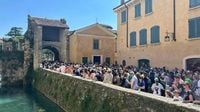Sirmione, a picturesque town on the banks of Lake Garda, found itself overwhelmed by an unprecedented influx of tourists during the May Day holiday weekend, leading to significant traffic congestion and public safety concerns. According to data from Confcommercio Brescia, the town welcomed nearly 41,000 visitors over three days, with 14,656 arriving on Thursday, May 1, alone. This marked a 16% increase compared to the previous Friday, April 25, and an astonishing 58% rise compared to Easter Sunday on April 20.
The surge in visitors was not just a one-day phenomenon; approximately 13,499 people visited on Friday, May 2, and 12,758 on Saturday, May 3, bringing the total to around 75,000 over the entire weekend. This influx far exceeded the town's population of about 8,000 residents, creating a chaotic scene in the historic center of Sirmione.
Videos circulating on social media captured the gridlock, showing tourists struggling to navigate the narrow streets and waiting for up to 40 minutes to cross the bridge leading into the town. The historic Castello Scaligero di Sirmione, a 13th-century fortress, became a focal point for many visitors, exacerbating the crowding.
Local authorities, including Marco Merlo, president of the hotel and restaurant operators association Federalberghi Brescia, expressed deep concern over the public safety and quality of life for both tourists and residents. "We’re very worried about public safety and the quality of life for tourists, residents, and workers," Merlo stated. He emphasized the need for the council to involve local stakeholders in developing effective crowd management strategies.
The situation prompted discussions among local officials about potential measures to mitigate overtourism. Massimo Padovan, the town's Security Assessor, proposed several ideas, including a mandatory reservation system during peak days, daily visitor limits, and a review of the parking system to encourage turnover and discourage long-term parking by transient visitors.
Despite these suggestions, Sirmione's mayor, Luisa Lavelli, clarified that no formal decisions had been made yet. She emphasized the importance of discussions with the town council and local business associations before implementing any new regulations. "Every proposal will be discussed in the council and with the relevant associations," Lavelli said.
Adding to the complexity, local council members Roberto Campagnola and Sofia Ermogene called for a more participatory approach to address the challenges posed by high tourist numbers. They proposed holding an open council meeting to engage citizens, business operators, and representatives from various sectors in crafting a sustainable tourism management model.
While the town's popularity is a testament to its charm, it also raises questions about sustainability. As the president of Confcommercio Brescia, Carlo Massoletti noted, "The data we have shows a significant and predictable increase on May 1, which has also been observed in other areas. However, the unique configuration of Sirmione’s historic center requires a different evaluation and regulation of tourism."
The peak of visitors on May 1 was particularly concentrated between 1 PM and 6 PM, with over 63% of the total visitors arriving during this time. This spike highlighted the urgent need for better crowd management strategies tailored to Sirmione's specific challenges.
Confesercenti della Lombardia Orientale, represented by president Barbara Quaresmini, emphasized that while the extraordinary visitor numbers during the May Day weekend confirm Sirmione's appeal, the focus should be on strengthening infrastructure and public services rather than imposing strict visitor limits. "We understand the need to reflect on the sustainability of tourist flows, but the real priority is to enhance infrastructure, connections, parking, public services, and land management across the entire Lake Garda region," Quaresmini said.
Moreover, local cultural associations, such as Siamo Sirmione, voiced their concerns about the impact of overtourism on the town's heritage and quality of life. They warned that if the current management model continues, it could lead to lasting damage to Sirmione's image and tourism appeal. "If this is the council’s management model, the risk is not just hardship for residents but a real and lasting harm for tourism and the image of Sirmione," the group stated.
Roberto Salaorni, a local councillor, acknowledged the need for improved crowd control measures. He suggested that while there are currently no plans to limit visitor numbers, better management of the flow of people is essential. "This is the first thing to do, possibly installing a barrier at the entrance to the castle, which would enable us to manage exceptional situations such as we saw on Friday," Salaorni explained.
As Sirmione grapples with the challenges of overtourism, the urgency for action has become increasingly clear. The town's administration has announced plans for an operational roundtable in the coming weeks to involve all stakeholders in addressing these pressing issues. The goal is to find a balance that allows tourists to enjoy Sirmione's unique offerings while preserving the quality of life for its residents.
With the summer tourist season approaching, the need for effective strategies to manage visitor numbers and enhance the overall experience for everyone involved is more critical than ever. The picturesque town of Sirmione stands at a crossroads, where the beauty of its heritage must be protected while accommodating the influx of those eager to experience its charm.





